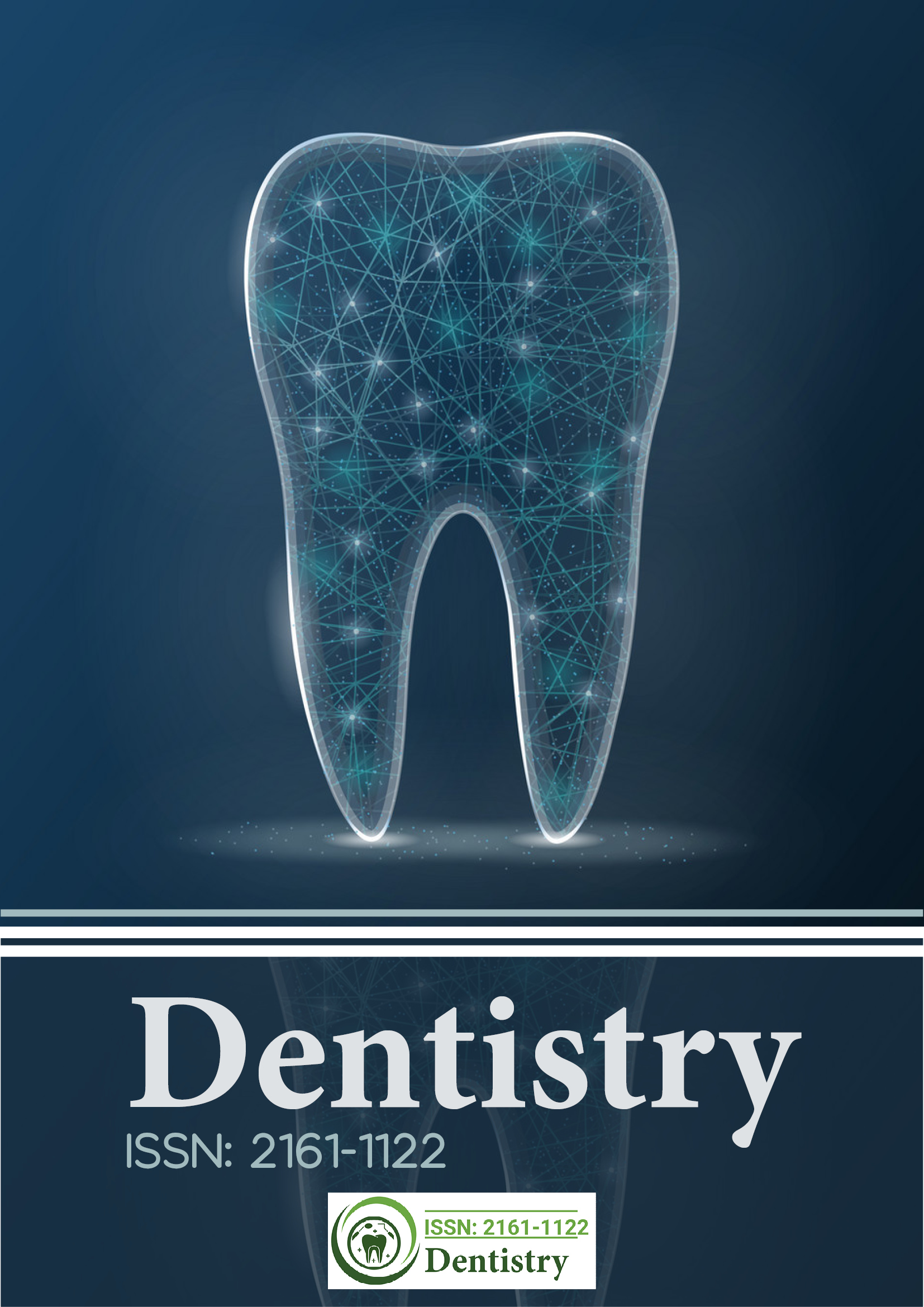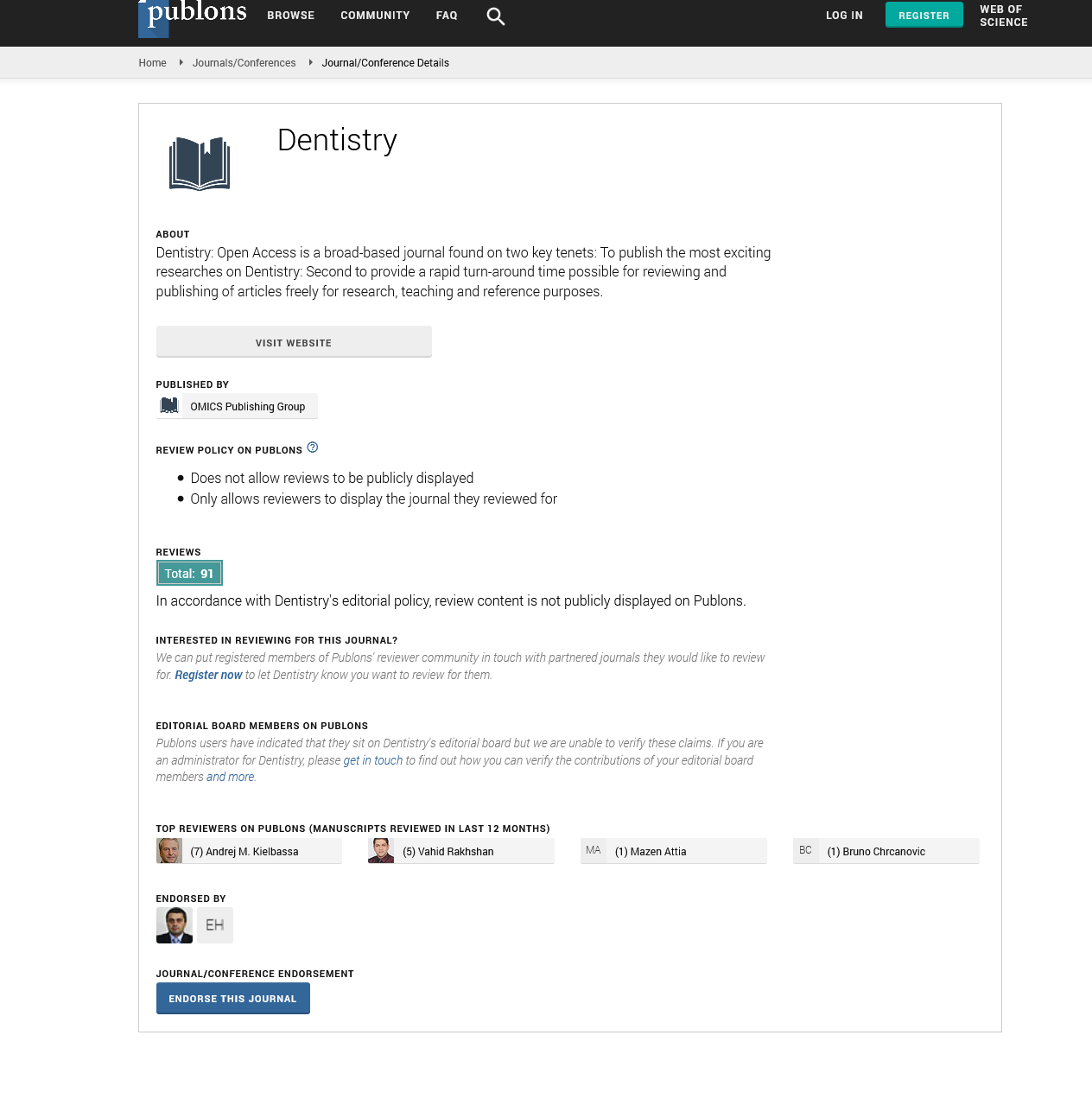Citations : 2345
Dentistry received 2345 citations as per Google Scholar report
Indexed In
- Genamics JournalSeek
- JournalTOCs
- CiteFactor
- Ulrich's Periodicals Directory
- RefSeek
- Hamdard University
- EBSCO A-Z
- Directory of Abstract Indexing for Journals
- OCLC- WorldCat
- Publons
- Geneva Foundation for Medical Education and Research
- Euro Pub
- Google Scholar
Useful Links
Share This Page
Journal Flyer

Open Access Journals
- Agri and Aquaculture
- Biochemistry
- Bioinformatics & Systems Biology
- Business & Management
- Chemistry
- Clinical Sciences
- Engineering
- Food & Nutrition
- General Science
- Genetics & Molecular Biology
- Immunology & Microbiology
- Medical Sciences
- Neuroscience & Psychology
- Nursing & Health Care
- Pharmaceutical Sciences
Perspective - (2024) Volume 14, Issue 2
Orthodontic Treatment Using Dental Prostheses to Restore Dental Health
Gustav Madsen*Received: 03-Jun-2024, Manuscript No. DCR-24-26159; Editor assigned: 05-Jun-2024, Pre QC No. DCR-24-26159 (PQ); Reviewed: 19-Jun-2024, QC No. DCR-24-26159; Revised: 26-Jun-2024, Manuscript No. DCR-24-26159 (R); Published: 03-Jul-2024, DOI: 10.35248/2161-1122.23.14.689
Description
Orthodontic treatment has long been recognized as essential for achieving and maintaining dental health, addressing issues such as malocclusion, misalignment, and irregular spacing of teeth. In recent years, advancements in dental prostheses have significantly enhanced orthodontic treatments, offering patients more effective and aesthetically pleasing solutions. Dental prostheses, which include crowns, dentures, and implants, play a fundamental role in restoring dental function and aesthetics, contributing to overall oral health. Orthodontic treatment focuses on diagnosing, preventing, and correcting dental and facial irregularities. Standard methods like braces and aligners aim to improve overall oral health, straighten teeth, and address bite problems. However, in cases where teeth are missing or severely damaged, dental prostheses become indispensable. Dental prostheses serve as artificial replacements for missing teeth and the surrounding tissues. They come in various forms, each suited to different dental conditions.
The integration of dental prostheses in orthodontic treatment has revolutionized the approach to restoring dental health. This integration offers several benefits, including improved function, aesthetic, one of the primary goals of orthodontic treatment is to restore proper function and appearance. Dental prostheses play a vital role in achieving this. For instance, when teeth are missing, it can lead to difficulties in chewing and speaking, as well as aesthetic concerns. Dental implants are highly effective in addressing these issues. They provide a stable foundation for artificial teeth, restoring natural function and appearance. Additionally, heads and connections help in maintaining the structural integrity of the mouth, ensuring that the remaining teeth do not shift out of alignment. Dental prostheses provide this stability. For example, implants act as anchors for orthodontic appliances, preventing them from flowing and ensuring that teeth move into the desired positions. This stability is essential for the success of orthodontic treatment, as it helps in achieving precise alignment and occlusion.
In complex cases where multiple teeth are missing or severely damaged, traditional orthodontic methods alone may not be sufficient. For instance, a patient with several missing teeth may face challenges with traditional braces due to the lack of teeth to anchor the appliances. In such scenarios, implants can be strategically placed to support orthodontic devices, enabling effective treatment. Prosthetics can also be made to match a patient's natural teeth, providing a smooth integration and a natural appearance. Missing teeth can lead to a host of complications, including bone loss, gum disease, and additional tooth loss. Dental prostheses help mitigate these risks. Implants, for instance, stimulate the jawbone, preventing bone resorption that typically follows tooth loss. By maintaining the jawbone's integrity, implants contribute to the overall health of the mouth. Additionally, prostheses such as crowns and bridges protect the remaining teeth from excessive wear and tear, reducing the risk of future dental issues.
Recent advancements in dental prostheses have significantly improved their effectiveness and patient comfort. Innovations such as 3D printing and digital scanning have transformed the way prostheses are designed and fabricated. These technologies allow for precise customization, ensuring a perfect fit and natural appearance. 3D printing has revolutionized the creation of dental prostheses. This technology allows for the accurate replication of the patient's dental structure, resulting in prostheses that fit perfectly. Digital scanning further enhances this process by providing detailed images of the patient's teeth and gums, which are then used to design the prosthesis. The combination of these technologies ensures that prostheses are not only functional but also comfortable and aesthetically pleasing. The development of biocompatible materials has also improved the success rate of dental prostheses. These materials, such as titanium for implants and ceramic for crowns, are designed to integrate seamlessly with the natural tissues in the mouth. This integration reduces the risk of rejection and ensures the longevity of the prosthesis. Additionally, biocompatible materials are often more durable and resistant to wear, providing long-term benefits for patients.
Traditional orthodontic treatments can be lengthy, often requiring several years to achieve the desired results. The use of dental prostheses can expedite this process. For instance, implants provide immediate support for orthodontic appliances, allowing for more efficient movement of teeth. Additionally, the precision offered by modern prosthetic technologies means that adjustments and refinements are minimal, further reducing treatment time. Comfort is a critical factor in patient satisfaction. Dental prostheses designed using advanced technologies are tailored to fit the patient's mouth perfectly, reducing discomfort. Furthermore, modern materials used in prostheses are designed to mimic the natural feel of teeth, enhancing overall comfort. This is particularly important for patients who may have previously experienced discomfort with traditional orthodontic appliances. Dental prostheses, especially those made from ceramic or porcelain, offer a natural appearance that blends seamlessly with the patient's existing teeth. This ensures that the final result is not only functional but also visually appealing. For many patients, this improvement in aesthetics boosts their confidence and overall satisfaction with the treatment.
Orthodontic treatment using dental prostheses has transformed the landscape of dental care, offering patients comprehensive solutions for restoring dental health. By integrating prostheses such as crowns, dentures, and implants, orthodontic treatments can address a wide range of dental issues, from simple to complex cases involving multiple missing teeth. As the field of orthodontics continues to evolve, the use of dental prostheses is likely to become even more integral to achieving optimal dental health. The combination of traditional orthodontic methods with advanced prosthetic solutions ensures that patients receive the best possible care, leading to improved function, aesthetics, and overall oral health. With ongoing innovations, the future of orthodontic treatment promises even greater advancements, ultimately benefiting patients and the broader field of dental care.
Citation: Madsen G (2024) Orthodontic Treatment Using Dental Prostheses to Restore Dental Health. J Dentistry. 14:689.
Copyright: © 2024 Madsen G. This is an open access article distributed under the terms of the Creative Commons Attribution License, which permits unrestricted use, distribution, and reproduction in any medium, provided the original author and source are credited.

